[English] 日本語
 Yorodumi
Yorodumi- PDB-3n84: Crystal Structure of the Grb2 SH2 Domain in Complex with a 23-Mem... -
+ Open data
Open data
- Basic information
Basic information
| Entry | Database: PDB / ID: 3n84 | |||||||||
|---|---|---|---|---|---|---|---|---|---|---|
| Title | Crystal Structure of the Grb2 SH2 Domain in Complex with a 23-Membered Macrocyclic Ligand Having the Sequence pYVNVP | |||||||||
 Components Components |
| |||||||||
 Keywords Keywords | protein binding/peptide / ligand preorganization / macrocycles / macrocyclic ligands / Golgi apparatus / Host-virus interaction / Phosphoprotein / protein binding-peptide complex | |||||||||
| Function / homology |  Function and homology information Function and homology informationguanyl-nucleotide exchange factor adaptor activity / Grb2-EGFR complex / branching involved in labyrinthine layer morphogenesis / STAT5 Activation / Co-inhibition by BTLA / COP9 signalosome / neurotrophin TRKA receptor binding / Activated NTRK2 signals through PI3K / transmembrane receptor protein tyrosine kinase adaptor activity / MET receptor recycling ...guanyl-nucleotide exchange factor adaptor activity / Grb2-EGFR complex / branching involved in labyrinthine layer morphogenesis / STAT5 Activation / Co-inhibition by BTLA / COP9 signalosome / neurotrophin TRKA receptor binding / Activated NTRK2 signals through PI3K / transmembrane receptor protein tyrosine kinase adaptor activity / MET receptor recycling / Signaling by cytosolic FGFR1 fusion mutants / Interleukin-15 signaling / MET activates PTPN11 / negative regulation of natural killer cell mediated cytotoxicity / MET activates RAP1 and RAC1 / vesicle membrane / Signaling by LTK / MET activates PI3K/AKT signaling / CD28 dependent Vav1 pathway / Signal regulatory protein family interactions / epidermal growth factor receptor binding / Regulation of KIT signaling / PI-3K cascade:FGFR3 / natural killer cell mediated cytotoxicity / STAT5 activation downstream of FLT3 ITD mutants / PI-3K cascade:FGFR2 / PI-3K cascade:FGFR4 / PI-3K cascade:FGFR1 / positive regulation of actin filament polymerization / endodermal cell differentiation / GRB2:SOS provides linkage to MAPK signaling for Integrins / RHOU GTPase cycle / regulation of MAPK cascade / RET signaling / PI3K events in ERBB2 signaling / insulin receptor substrate binding / Interleukin-3, Interleukin-5 and GM-CSF signaling / PI3K Cascade / SOS-mediated signalling / Activated NTRK3 signals through RAS / Activated NTRK2 signals through RAS / signal transduction in response to DNA damage / fibroblast growth factor receptor signaling pathway / SHC1 events in ERBB4 signaling / RHO GTPases Activate WASPs and WAVEs / Role of LAT2/NTAL/LAB on calcium mobilization / Interleukin receptor SHC signaling / Signalling to RAS / GAB1 signalosome / Signal attenuation / Activated NTRK2 signals through FRS2 and FRS3 / SHC-related events triggered by IGF1R / Schwann cell development / SHC-mediated cascade:FGFR3 / MET activates RAS signaling / SHC-mediated cascade:FGFR2 / Signaling by PDGFRA transmembrane, juxtamembrane and kinase domain mutants / Signaling by PDGFRA extracellular domain mutants / SHC-mediated cascade:FGFR4 / Erythropoietin activates RAS / Signaling by FGFR4 in disease / SHC-mediated cascade:FGFR1 / FRS-mediated FGFR3 signaling / Signaling by CSF3 (G-CSF) / Signaling by FLT3 ITD and TKD mutants / ephrin receptor binding / FRS-mediated FGFR2 signaling / FRS-mediated FGFR4 signaling / InlB-mediated entry of Listeria monocytogenes into host cell / Signaling by FGFR3 in disease / FRS-mediated FGFR1 signaling / Tie2 Signaling / Signaling by FGFR2 in disease / phosphotyrosine residue binding / GRB2 events in EGFR signaling / SHC1 events in EGFR signaling / myelination / Signaling by FLT3 fusion proteins / FLT3 Signaling / EGFR Transactivation by Gastrin / Signaling by FGFR1 in disease / FCERI mediated Ca+2 mobilization / NCAM signaling for neurite out-growth / GRB2 events in ERBB2 signaling / cellular response to ionizing radiation / Downstream signal transduction / SHC1 events in ERBB2 signaling / Insulin receptor signalling cascade / insulin-like growth factor receptor signaling pathway / Regulation of signaling by CBL / Negative regulation of FGFR3 signaling / Antigen activates B Cell Receptor (BCR) leading to generation of second messengers / Constitutive Signaling by Overexpressed ERBB2 / Signaling by phosphorylated juxtamembrane, extracellular and kinase domain KIT mutants / T cell activation / Negative regulation of FGFR2 signaling / Negative regulation of FGFR4 signaling / Negative regulation of FGFR1 signaling / EGFR downregulation / Spry regulation of FGF signaling Similarity search - Function | |||||||||
| Biological species |  Homo sapiens (human) Homo sapiens (human) | |||||||||
| Method |  X-RAY DIFFRACTION / X-RAY DIFFRACTION /  MOLECULAR REPLACEMENT / Resolution: 2 Å MOLECULAR REPLACEMENT / Resolution: 2 Å | |||||||||
 Authors Authors | Clements, J.H. / Martin, S.F. | |||||||||
 Citation Citation |  Journal: ACS MED.CHEM.LETT. / Year: 2010 Journal: ACS MED.CHEM.LETT. / Year: 2010Title: Thermodynamic and Structural Effects of Macrocyclization as a Constraining Method in Protein-Ligand Interactions. Authors: Delorbe, J.E. / Clements, J.H. / Whiddon, B.B. / Martin, S.F. | |||||||||
| History |
|
- Structure visualization
Structure visualization
| Structure viewer | Molecule:  Molmil Molmil Jmol/JSmol Jmol/JSmol |
|---|
- Downloads & links
Downloads & links
- Download
Download
| PDBx/mmCIF format |  3n84.cif.gz 3n84.cif.gz | 166.9 KB | Display |  PDBx/mmCIF format PDBx/mmCIF format |
|---|---|---|---|---|
| PDB format |  pdb3n84.ent.gz pdb3n84.ent.gz | 131.9 KB | Display |  PDB format PDB format |
| PDBx/mmJSON format |  3n84.json.gz 3n84.json.gz | Tree view |  PDBx/mmJSON format PDBx/mmJSON format | |
| Others |  Other downloads Other downloads |
-Validation report
| Summary document |  3n84_validation.pdf.gz 3n84_validation.pdf.gz | 515.7 KB | Display |  wwPDB validaton report wwPDB validaton report |
|---|---|---|---|---|
| Full document |  3n84_full_validation.pdf.gz 3n84_full_validation.pdf.gz | 523.7 KB | Display | |
| Data in XML |  3n84_validation.xml.gz 3n84_validation.xml.gz | 35.2 KB | Display | |
| Data in CIF |  3n84_validation.cif.gz 3n84_validation.cif.gz | 51.4 KB | Display | |
| Arichive directory |  https://data.pdbj.org/pub/pdb/validation_reports/n8/3n84 https://data.pdbj.org/pub/pdb/validation_reports/n8/3n84 ftp://data.pdbj.org/pub/pdb/validation_reports/n8/3n84 ftp://data.pdbj.org/pub/pdb/validation_reports/n8/3n84 | HTTPS FTP |
-Related structure data
| Related structure data | 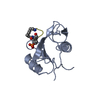 3n7yC 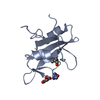 3n8mC  2huwS C: citing same article ( S: Starting model for refinement |
|---|---|
| Similar structure data |
- Links
Links
- Assembly
Assembly
| Deposited unit | 
| ||||||||||||
|---|---|---|---|---|---|---|---|---|---|---|---|---|---|
| 1 | 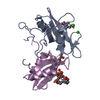
| ||||||||||||
| 2 | 
| ||||||||||||
| 3 | 
| ||||||||||||
| 4 | 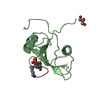
| ||||||||||||
| 5 | 
| ||||||||||||
| 6 | 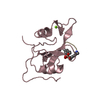
| ||||||||||||
| 7 | 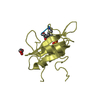
| ||||||||||||
| 8 | 
| ||||||||||||
| 9 | 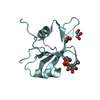
| ||||||||||||
| Unit cell |
| ||||||||||||
| Components on special symmetry positions |
| ||||||||||||
| Details | There are six biological units in the asymmetric unit (chains A-F) each present as a complex with the macrocyclic ligand (chains G-L) |
- Components
Components
-Protein / Protein/peptide , 2 types, 12 molecules ABCDEFGHIJKL
| #1: Protein | Mass: 13060.855 Da / Num. of mol.: 6 / Fragment: SH2 domain Source method: isolated from a genetically manipulated source Details: Protein was expressed with a C-terminal six-HIS tag Source: (gene. exp.)  Homo sapiens (human) / Gene: GRB2, ASH / Plasmid: pQE-60 / Production host: Homo sapiens (human) / Gene: GRB2, ASH / Plasmid: pQE-60 / Production host:  #2: Protein/peptide | Mass: 797.832 Da / Num. of mol.: 6 / Source method: obtained synthetically / Details: pYVNVP-containing sequence |
|---|
-Non-polymers , 4 types, 738 molecules 






| #3: Chemical | | #4: Chemical | ChemComp-GOL / #5: Chemical | ChemComp-MG / | #6: Water | ChemComp-HOH / | |
|---|
-Details
| Has protein modification | Y |
|---|
-Experimental details
-Experiment
| Experiment | Method:  X-RAY DIFFRACTION / Number of used crystals: 1 X-RAY DIFFRACTION / Number of used crystals: 1 |
|---|
- Sample preparation
Sample preparation
| Crystal | Density Matthews: 2.22 Å3/Da / Density % sol: 44.62 % |
|---|---|
| Crystal grow | Temperature: 298 K / Method: vapor diffusion, hanging drop / pH: 8.5 Details: Ligand in lyoophilized powder form was dissolved in a 8.0 mg/mL solution of Grb2 SH2 in water such to give a protein/ligand molar ratio of 1:1.7. 4 uL of this solution was mixed with 3 uL of ...Details: Ligand in lyoophilized powder form was dissolved in a 8.0 mg/mL solution of Grb2 SH2 in water such to give a protein/ligand molar ratio of 1:1.7. 4 uL of this solution was mixed with 3 uL of 30% w/v polyethylene glycol MW 4000, 0.2 M magnesium chloride hexahydrate, 0.1 M TRIS, pH 8.5 to create the hanging drop, which yielded usable crystals after 8 weeks., VAPOR DIFFUSION, HANGING DROP, temperature 298K |
-Data collection
| Diffraction | Mean temperature: 100 K |
|---|---|
| Diffraction source | Source:  ROTATING ANODE / Type: RIGAKU RU200 / Wavelength: 1.5418 Å ROTATING ANODE / Type: RIGAKU RU200 / Wavelength: 1.5418 Å |
| Detector | Type: MAR scanner 345 mm plate / Detector: IMAGE PLATE / Date: Jul 11, 2007 |
| Radiation | Monochromator: Blue max-flux confocal / Protocol: SINGLE WAVELENGTH / Monochromatic (M) / Laue (L): M / Scattering type: x-ray |
| Radiation wavelength | Wavelength: 1.5418 Å / Relative weight: 1 |
| Reflection | Resolution: 1.69→50 Å / Num. all: 80867 / Num. obs: 73832 / % possible obs: 91.3 % / Observed criterion σ(F): 0 / Observed criterion σ(I): 0 / Redundancy: 5.8 % / Rmerge(I) obs: 0.066 / Net I/σ(I): 24.5 |
| Reflection shell | Resolution: 1.69→1.75 Å / Redundancy: 4.1 % / Rmerge(I) obs: 0.275 / Mean I/σ(I) obs: 3.7 / Num. unique all: 7850 / % possible all: 69.4 |
- Processing
Processing
| Software |
| |||||||||||||||||||||||||
|---|---|---|---|---|---|---|---|---|---|---|---|---|---|---|---|---|---|---|---|---|---|---|---|---|---|---|
| Refinement | Method to determine structure:  MOLECULAR REPLACEMENT MOLECULAR REPLACEMENTStarting model: 2HUW Resolution: 2→50 Å / Cross valid method: THROUGHOUT / σ(F): 0 / σ(I): 0 / Stereochemistry target values: Engh & Huber
| |||||||||||||||||||||||||
| Displacement parameters |
| |||||||||||||||||||||||||
| Refinement step | Cycle: LAST / Resolution: 2→50 Å
|
 Movie
Movie Controller
Controller


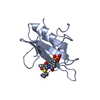


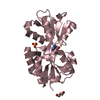
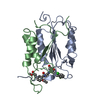
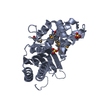



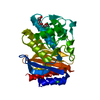
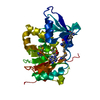
 PDBj
PDBj


























